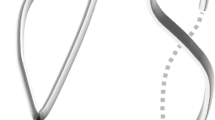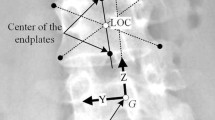Abstract
The S-shaped curvature of the spine has been hypothesized as the underlying mechanical cause of adolescent idiopathic scoliosis. In earlier work, we proposed a reduced-order model in which the spine was viewed as an S-shaped elastic rod under torsion and bending. Here, we simulate the deformation of S-shaped rods of a wide range of curvatures and inflection points under a fixed mechanical loading. Our analysis determines three distinct axial projection patterns of these S-shaped rods: two loop (in opposite directions) patterns and one Lemniscate pattern. We further identify the curve characteristics associated with each deformation pattern, showing that for rods deforming in a Loop1 shape the position of the inflection point is the highest and the curvature of the rod is smaller compared to the other two types. For rods deforming in the Loop2 shape, the position of the inflection point is the lowest (closer to the fixed base) and the curvatures are higher than the other two types. These patterns matched the common clinically observed scoliotic curves—Lenke 1 and Lenke 5. Our S-shaped elastic rod model generates deformations that are similar to those of a pediatric spine with the same sagittal curvature characteristics and it can differentiate between the clinically observed deformation patterns.










Similar content being viewed by others
References
Antman S (2006) Nonlinear problems of elasticity. Applied Mathematical Sciences. Springer, New York
Audoly B, Pomeau Y (2010) From hair curls to the non-linear response of shells. Elasticity and geometry. OUP Oxford, Oxford
Belytschko T, Andriacchi T, Schultz A, Galante J (1973) Analog studies of forces in the human spine: computational techniques. J Biomech 6(4):361–371
Brink RC, Schlösser TP, van Stralen M, Vincken KL, Kruyt MC, Hui SC, Viergever MA, Chu WC, Cheng JC, Castelein RM (2018) Anterior–posterior length discrepancy of the spinal column in adolescent idiopathic scoliosis—a 3d ct study. Spine J 18(12):2259–2265
Burwell RG (2003) Aetiology of idiopathic scoliosis: current concepts. Pediatr Rehab 6(3–4):137–170
Castelein RM, Veraart B (1992) Idiopathic scoliosis: prognostic value of the profile. Eur Spine J 1(3):167–169
Castelein RM, van Dieen JH, Smit TH (2005) The role of dorsal shear forces in the pathogenesis of adolescent idiopathic scoliosis—a hypothesis. Med Hypotheses 65(3):501–508
Cheng JC, Castelein RM, Chu WC, Danielsson AJ, Dobbs MB, Grivas TB, Gurnett CA, Luk KD, Moreau A, Newton PO, Stokes IA, Weinstein SL, Burwell RG (2015) Adolescent idiopathic scoliosis. Nat Rev Disease Primers 1(1):15030
Chu WC, Lam WM, Ng BK, Tze-ping L, Lee K-M, Guo X, Cheng JC, Burwell RG, Dangerfield PH, Jaspan T (2008) Relative shortening and functional tethering of spinal cord in adolescent scoliosis—result of asynchronous neuro-osseous growth, summary of an electronic focus group debate of the IBSE. Scoliosis 3(1):8
Crisco JJ, Panjabi MM (1992) Euler stability of the human ligamentous lumbar spine. Part I: theory. Clin Biomech (Bristol, Avon) 7(1):19–26
Crisco JJ, Panjabi MM, Yamamoto I, Oxland TR (1992) Euler stability of the human ligamentous lumbar spine. Part II: experiment. Clin Biomech (Bristol, Avon) 7(1):27–32
de Reuver S, Brink R, Homans J, Kruyt M, van Stralen M, Schlösser T, Castelein R (2018) The changing position of the center of mass of the thorax during growth in relation to pre-existent vertebral rotation. SPINE 44(10):679–684
Duong L, Cheriet F, Labelle H (2006) Three-dimensional classification of spinal deformities using fuzzy clustering. Spine 31(8):923–30
Goto M, Kawakami N, Azegami H, Matsuyama Y, Takeuchi K, Sasaoka R (2003) Buckling and bone modeling as factors in the development of idiopathic scoliosis. Spine (Phila Pa 1976) 28(4):364–371
Gu S-X, Wang C-F, Zhao Y-C, Zhu X-D, Li M (2009) Abnormal ossification as a cause the progression of adolescent idiopathic scoliosis. Med Hypotheses 72(4):416–417
Janssen MMA, Kouwenhoven J-WM, Schlösser TPC, Viergever MA, Bartels LW, Castelein RM, Vincken KL (2011) Analysis of preexistent vertebral rotation in the normal infantile, juvenile, and adolescent spine. Spine 36(7):E486–91
Kouwenhoven J-WM, Vincken KL, Bartels LW, Castelein RM (2006) Analysis of preexistent vertebral rotation in the normal spine. Spine 31(13):1467–72
Liu Z, Tam EMS, Sun G-Q, Lam T-P, Zhu Z-Z, Sun X, Lee K-M, Ng T-B, Qiu Y, Cheng JCY, Yeung H-Y (2012) Abnormal leptin bioavailability in adolescent idiopathic scoliosis: an important new finding. Spine 37(7):599–604
Lucas DB (1970) Mechanics of the spine. Bull Hosp Joint Diseases Orthop Inst 31(2):115–131
Lucas DB, Boris B (1961) Stability of the Ligamentous Spine. N.p.: Biomechanics Laboratory, U of California. Print
Meakin JR, Hukins DWL, Aspden RM (1996) Euler buckling as a model for the curvature and flexion of the human lumbar spine. Proc R Soc Lond Ser B Biol Sci 263(1375):1383–1387
Neelakantan S, Purohit PK, Pasha S (2020) A semi-analytic elastic rod model of pediatric spinal deformity. J Biomech Eng (under review)
Nizette M, Goriely A (1999) Towards a classification of Euler–Kirchhoff filaments. J Math Phys 40(6):2830–2866
Pasha S (2019a) 3D deformation patterns of S-shaped elastic rods as a pathogenesis model for spinal deformity in adolescent idiopathic scoliosis. Sci Rep 9(1):16485
Pasha S (2019b) 3D spinal and rib cage predictors of brace effectiveness in adolescent idiopathic scoliosis. BMC Musculoskelet Disord 20:384
Pasha S, Baldwin K (2019a) Surgical outcome differences between the 3D subtypes of right thoracic adolescent idiopathic scoliosis. Eur Spine J 28:3076–3084
Pasha S, Baldwin K (2019b) Preoperative sagittal spinal profile of adolescent idiopathic scoliosis lenke types and non-scoliotic adolescents: A systematic review and meta-analysis. Spine (Phila Pa 1976) 44(2):134–142
Pasha S, Aubin CE, Sangole AP, Labelle H, Parent S, Mac-Thiong JM (2014a) Three-dimensional spinopelvic relative alignment in adolescent idiopathic scoliosis. Spine (Phila Pa 1976) 39(7):564–70
Pasha S, Aubin C-E, Parent S, Labelle H, Mac-Thiong J-M (2014b) Biomechanical loading of the sacrum in adolescent idiopathic scoliosis. Clin Biomech 29(3):296–303
Pasha S, Hassanzadeh P, Ecker M, Ho V (2019a) A hierarchical classification of adolescent idiopathic scoliosis: identifying the distinguishing features in 3d spinal deformities. PLOS ONE 14(3):1–12
Pasha S, Sankar WN, Castelein RM (2019b) The link between the 3d spino-pelvic alignment and vertebral body morphology in adolescent idiopathic scoliosis. Spine Deform 7(1):53–59
Pasha S, Smith L, Sankar WN (2019c) Bone remodeling and disc morphology in the distal unfused spine after spinal fusion in adolescent idiopathic scoliosis. Spine Deform 7(5):746–753
Pasha S (2020) What causes different coronal curve patterns in idiopathic scoliosis? bioRxiv. https://doi.org/10.1101/2020.01.21.913707.
Schlösser TP, Shah SA, Reichard SJ, Rogers K, Vincken KL, Castelein RM (2014) Differences in early sagittal plane alignment between thoracic and lumbar adolescent idiopathic scoliosis. Spine J 14(2):282–290
Schlösser TPC, Vincken KL, Rogers K, Castelein RM, Shah SA (2015) Natural sagittal spino-pelvic alignment in boys and girls before, at and after the adolescent growth spurt. Eur Spine J 24:1158–1167
Stokes IA, Aronsson DD, Spence H, Iatridis JC (1998) Mechanical modulation of intervertebral disc thickness in growing rat tails. J Spinal Disord 11(3):261–265
Weinstein SL, Dolan LA, Cheng JC, Danielsson A, Morcuende JA (2008) Adolescent idiopathic scoliosis. The Lancet 371(9623):1527–1537
Acknowledgements
Sunder Neelakantan and Prashant K. Purohit acknowledge partial support for this work through an NSF Grant NSF CMMI 1662101. Saba Pasha acknowledges partial support for this work through a research grant from the Scoliosis Research Society and the National Institute of Health (NIH) R21 AR075971 01A1.
Author information
Authors and Affiliations
Corresponding author
Ethics declarations
Conflict of interest
The authors declare that they have no conflict of interest.
Additional information
Publisher's Note
Springer Nature remains neutral with regard to jurisdictional claims in published maps and institutional affiliations.
Appendix
Appendix
We present the sagittal view of the deformed configuration of the rods presented in Fig. 8 in Fig. 11. We see that the rods bend toward the +ve y- axis, which would be the case given a -ve \(m_x(s)\) moment acting along the length of the rod.
Sagittal view of the deformed configuration of the \({37}^{\circ }\) average curve in Fig. 8
We present the equations of the surfaces and the coefficient of determination(\({\varvec{R^2}}\)) used in Fig. 3 in Tables 4 and 5. We present the equations of the loop–Lemniscate classification surfaces in Table 4. We also present the equations of the surfaces generated from the uprightness check in Table 5.
Rights and permissions
About this article
Cite this article
Neelakantan, S., Purohit, P.K. & Pasha, S. A reduced-order model of the spine to study pediatric scoliosis. Biomech Model Mechanobiol 20, 467–480 (2021). https://doi.org/10.1007/s10237-020-01394-5
Received:
Accepted:
Published:
Issue Date:
DOI: https://doi.org/10.1007/s10237-020-01394-5





